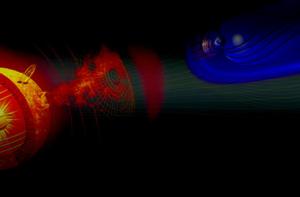Solar stormsNew urgency in preparing for solar storm Big One
The specter of a geomagnetic solar storm with the ferocity to disrupt communications satellites, knock out GPS systems, shut down air travel and quench lights, computers and telephones in millions of homes for days, months, or even years has yet to grip the public as a panic-inducing possibility. But it is a scenario that space scientists, global insurance corporations and government agencies from the Department of Homeland Security (DHS) to NASA to the White House Office of Science and Technology Policy (OSTP) take seriously, calling it a “low probability but high-impact event” that merits a substantial push on several fronts: research, forecasting, and mitigation strategy.

Rendering of solar storm impacting earth's magnetic field // Source: commons.wikimedia.org
The specter of a geomagnetic solar storm with the ferocity to disrupt communications satellites, knock out GPS systems, shut down air travel and quench lights, computers and telephones in millions of homes for days, months or even years has yet to grip the public as a panic-inducing possibility. But it is a scenario that space scientists, global insurance corporations and government agencies from the Department of Homeland Security (DHS) to NASA to the White House Office of Science and Technology Policy (OSTP) take seriously, calling it a “low probability but high-impact event” that merits a substantial push on several fronts: research, forecasting and mitigation strategy.
Space weather experts gather
NJIT reports that at a recent conference in Washington, D.C. that drew space weather specialists from academia, the federal government, the military and private industry, Louis Lanzerotti, distinguished research professor at NJIT’s Center for Solar-Terrestrial Research, summed up the implications of a massive, well-timed solar storm for today’s technology-based, hyper-connected global society:
“Since the development of the electrical telegraph in the 1840s, space weather processes have affected the design, implementation and operation of many engineered systems, at first on Earth and now in space,” noted Lanzerotti, a panelist at the conference. “As the complexity of such systems increases, as new technologies are invented and deployed, and as humans have ventured beyond Earth’s surface, both human-built systems and humans themselves become more susceptible to the effects of Earth’s space environment.”
In addition to disrupting communications and energy grids, what is broadly known as space weather – powerful bursts of electromagnetic radiation, energetic charged particles and magnetized plasma – has the potential to corrode water and sewer pipelines, to erase historical data stored in computer memory, to undermine military and security operations and to harm astronauts traveling in space.
The symposium, “Space Weather Science and Applications: Research for Today, Training for Tomorrow,” sponsored by the Universities Space Research Association (USRA) and the Space Policy Institute at George Washington University, focused on the growing urgency for both basic scientific research and the development of practical applications in the field.
“Once systems start to fail, (the outages) could cascade in ways we can’t even conceive,” said Daniel Baker, director of the Laboratory for Atmospheric and Space Physics at the University of Colorado-Boulder and also a panelist, who recommends increasing support for the development of engineering systems and devices capable of protecting Earth’s infrastructure.
